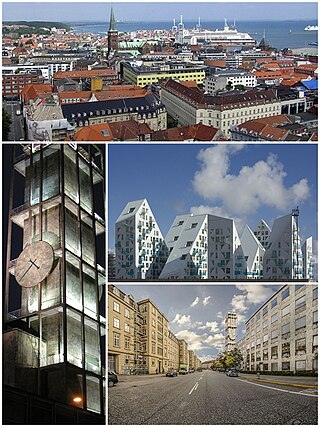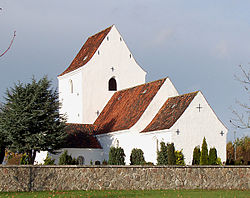
Aarhus is the second-largest city in Denmark and the seat of Aarhus Municipality. It is located on the eastern shore of Jutland in the Kattegat sea and approximately 187 kilometres (116 mi) northwest of Copenhagen.

Brønderslev is a city in Denmark with a population of 12,884. The city is the largest urban area in Brønderslev Municipality and is the municipal seat. It is the fourth largest city of Vendsyssel within the North Jutland Region.

Skåneland or Skånelandene (Danish) is a region on the southern Scandinavian peninsula. It includes the Swedish provinces of Blekinge, Halland, and Scania. The Danish island of Bornholm is traditionally also included. Skåneland has no official recognition or function and the term is not in common usage. Equivalent terms in English and Latin are "the Scanian Provinces" and "Terrae Scaniae" respectively. The term is mostly used in historical contexts and not in daily speech. In Danish, Skånelandene is used more often. The terms have no political implications as the region is not a political entity but a cultural region, without officially established administrative borders.

Tilst is a suburban area of Aarhus, Denmark, situated some 10 km to the west of Aarhus.

Aarhus Stadium is an association football stadium in Aarhus, Denmark which has been the home ground of Aarhus Gymnastikforening since the 1920s. With a current capacity of 19,433, it is the third largest football stadium of any football team in Denmark. It is part of the sports complex, known as Aarhus Sports Park, that is run by Ceres Park & Arena.
Johannes Sløk was a Danish philosopher, professor at the University of Aarhus and founder of "Idéhistorie", an interdisciplinary discipline mainly about writings pertaining to the ideas of Western culture since Antiquity. The concept is now the "Department of Philosophy and History of Ideas" a department under the faculty of humanities of Aarhus University. During the student rising of 1968, Sløk was forced to leave his position as professor at Idéhistorie, and the institute became oriented around the Marxist theory. Sløk instead was granted a special position at the Department of Theology, as professor of analytic theology. Sløk was one of the four Aarhus theologians and wrote a series of books on religion and its meaning to the modern man.

The former Diocese of Børglum was a Roman Catholic diocese in Northern Jutland, Denmark. It has also been referred to as the Diocese of Vestervig or the Bishopric of Vendsyssel. The diocese included Vendsyssel, Hanherred, Thy, and Mors.

Assentoft is a Danish town on the peninsula of Jutland with a population of 3,822 in 2023. The town is located eight kilometers east of Randers, and is a part of the Randers Municipality in the Central Denmark Region.

Malling is a village in Denmark, located about 12 km (7.5 mi) south of Aarhus. It has a population of 6,194 (Jan 1, 2020).

Aaby, or Åby, is a suburban area of Aarhus in Denmark. Located 4 km from the city centre of Aarhus, Åby was originally an old village, but is now an integrated a part of Åbyhøj, that sprawled around it. To distinguish Åby from Åbyhøj, the village area is often referred to as Gammel Åby. Åby is situated at a bend of the Aarhus River and there is access to the river and the pathway of Brabrandstien from here.

Mårslet is a railway town in Denmark, located about 11 km (6.8 mi) south of Aarhus. It has a population of 5,162. Mårslet is located in Aarhus Municipality and therefore is part of the Central Denmark Region.

Fredensborg is a railway town located in Fredensborg Municipality, North Zealand, some 30 kilometres north of Copenhagen, Denmark. It is most known for Fredensborg Palace, one of the official residences of the Danish royal family. As of 1 January 2023, the town had a population of 8,960.
The Robert Award for Best Actor in a Leading Role is a Danish Film Academy award presented at the annual Robert Award ceremony to recognize an actor who has delivered an outstanding leading performance in a Danish film.
The following is a timeline of the history of the city of Aarhus, a city in central Denmark.

Tranbjerg Church is a church in Aarhus, Denmark, situated in the suburb Tranbjerg, 9 kilometers south-west of Aarhus city center, on the old country road between Aarhus and Horsens. Tranbjerg Church is from the 1100s, erected as a typical Danish Romanesque village church. Later additions in the 15th century added a Gothic tower and porch. Tranbjerg Church is the only church in Tranbjerg pastorate and Parish, with 7.414 members of the Church of Denmark living in Tranbjerg Parish on 1 January 2016. Tranbjerg Church is devoted to St. Ursula and the 11,000 virgin handmaidens.

The L-groups was a resistance group tasked with assassination of Danish collaborators and German forces occupying Denmark during the Second World War. The precursor to the group was established in 1940, but it was most active from 1944 to the end of the war. The group carried out at least 18 assassination operations and killed between 20 and 30 people. In 1945 the group was hard hit by arrests and killings of its members and further suffered a very high death-rate in the years immediately after the war with suicides and accidents killing a number of members. The group had strong ties to the Danish police, with 5 of its members being police officers.
Drastrup is a village on the peninsula of Jutland, with a population of 28 (2010). It is a part of Randers Municipality in the Central Denmark Region. The village is gradually becoming enveloped by the growth of Assentoft.

Hjøllund is a village in Denmark, 18 km southwest of Silkeborg. It is part of Silkeborg Kommune in Region Midtjylland.

Idrætsforeningen Lyseng Fodbold, commonly known as IF Lyseng, is an association football club based in the suburb of Højbjerg, Aarhus Municipality, Denmark, that competes in the Danish 3rd Division, the fourth tier of the Danish football league system. The club's name comes from its home ground, which is located on the former land of Lysenggård, a farm in Højbjerg. The football department is the most notable one of Idrætsforeningen Lyseng, a major multi-sport club who compete in football, handball, volleyball, swimming and beach volleyball, among others.
The 1964 Danish 3rd Division was the twenty-third season of the Danish third-tier association football division since its establishment in 1936 as part of the Danmarksturneringen's nation-wide league structure. Governed by the Danish FA, the season was launched on 26 March 1964 with two fixtures and concluded with the last four matches on 15 November 1964. Skovshoved IF and Hellerup IK entered as relegated teams from last season's second division, while Svendborg fB and Nakskov BK entered as promoted teams from the 1963 Kvalifikationsturneringen. The twelve teams in the division entered the 1964–65 Danish Cup in the cup tournament's first round proper.



















